An extremely accurate and quick high throughput analysis is provided by Micromeritics® TriStar II Plus, a fully automated surface area and porosity analyzer.
- Ideal for high throughput sample analysis
- Competitive cost
- High analysis versatility
- Rapid and accurate measurement
- Krypton option for low surface area measurements
- Long-lasting dewar to accommodate longer analysis
- Fully automated analysis
- Enhanced data reduction
Description
The three-station unit meets research requirements for accuracy, resolution, and data reduction while also improving the speed and efficiency of routine quality control analyses. The instrument allows for customized analyses based on application requirements by combining data reduction and versatile analysis methods.
Features and Benefits
- The TriStar II Plus offers an efficient high-throughput system with three independently operating sample ports. To further enhance throughput, up to four units can be managed by a single computer.
- The standard nitrogen system can accurately measure surface areas as low as 0.01 m²/g. The Krypton Option extends surface area measurements to as low as 0.001 m²/g.
- The TriStar II Plus is versatile, supporting analyses with various adsorbates, including argon, carbon dioxide, and other noncorrosive gases like butane, methane, and other light hydrocarbons.
- For maximum flexibility in handling special sample types and prioritizing speed when necessary, free space measurements can be conducted, calculated, or manually entered.
- Isothermal Jackets ensure a consistent thermal profile along the entire length of both sample and saturation pressure (Po) tubes.
- The Micromeritics MicroActive data reduction and control software empowers users to calculate surface area and porosity interactively. The graphic interface allows users to select data ranges for direct modeling, including BET, t-Plot, Langmuir, and DFT interpretation.
- With enhanced software capabilities, the TriStar II Plus enables the generation of comprehensive pore size distribution data through gas adsorption, mercury intrusion overlay, and advanced NLDFT.
Specification
Source: Micromeritics Instrument Corporation
| Pressure Measurement |
| Absolute |
Range: 0 to 950 mmHg
Resolution: Within 0.05 mmHg
Accuracy: Within 0.1% of full scale
Linearity: < ± 0.1% of span |
| Relative |
P/Po range: 0 to 1.0 P/Po
Resolution: < 10-4 |
| Analysis |
| Specific Surface Area |
From 0.01 m2/g, nitrogen unit
From 0.001 m2/g, krypton unit |
| Total Surface Area |
From 0.1 m2, nitrogen unit
From 0.01 m2, krypton unit |
| Pore Volume |
From 4 × 10-6 cm³/g |
| Dewar Duration |
Up to 40 hours |
| Gas Consumption |
Up to 300 cm³ STP per port |
| Adsorptive Gases |
| Nitrogen Unit |
Nitrogen; argon, carbon dioxide, or other non-corrosive gases; butane, methane, or other light hydrocarbon vapors. Oxygen can also be used only with an appropriate vacuum pump. |
| Krypton Unit |
Same as nitrogen unit, plus the capability to perform krypton surface area analyses at lower pressures |
| The TriStar II Plus should be operated in a properly vented environment when using flammable or toxic gases. |
| Manifold Temperature |
| Accuracy |
±0.25 °C |
| Resolution |
Within 0.1 °C |
| Vacuum System |
| Nitrogen Unit |
Must accommodate 20 × 10-3 mmHg or better; uses oil-based or oil-free vacuum pump |
| Krypton Unit |
Must accommodate 1 × 10-3 mmHg; oil-free vacuum pump required |
| Operating Environment |
| Temperature |
10 to 35 °C (50 to 95 °F), operating
0 to 50 °C (32 to 122 °F), non-operating |
| Humidity |
20 to 80% relative, non-condensing |
| Indoor or Outdoor Use |
Indoor only
Altitude: 2000 m maximum
Pollution degree of the intended environment: 2 |
| Physical |
| Height |
74 cm (29 in.) |
| Width |
40 cm (16 in.) |
| Depth |
51 cm (20 in.) |
| Weight |
37 kg (82 lbs) |
| Electrical |
| Voltage |
100-240 V~ |
| Power |
150 VA, maximum |
| Frequency |
50/60 Hz |
| Overvoltage category |
II |
Technology
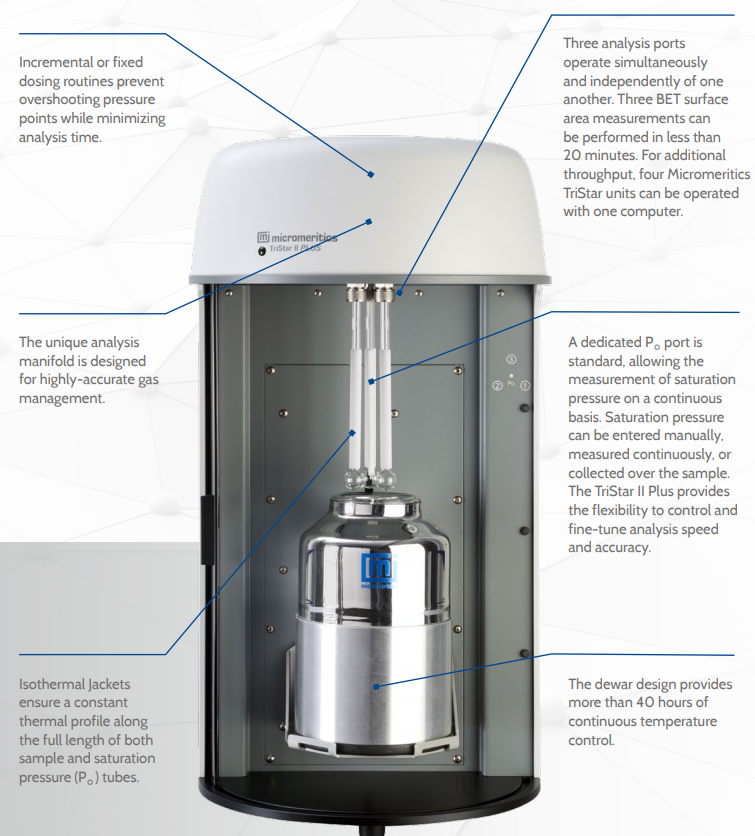
Image Credit: Micromeritics Instrument Corporation
Application
Additive Manufacturing
When examining the sintering process's kinetics and final product's characteristics, surface area is essential. Specific surface areas are typically higher for particles with internal porosity or rough surfaces. Therefore, the surface area indicates the sample surface available for reaction with other component particles and/or the surrounding environment.
Carbon Black
The surface area of carbon blacks used in tire production is correlated with wear life, traction, and performance. Controlling the porosity of artificial bone implants enables them to mimic real bone, thus promoting the body's acceptance and facilitating the growth of tissue around them.
Adsorbents
Understanding surface area, total pore volume, and pore size distribution is crucial to developing separation procedures and maintaining the quality of industrial adsorbents. The characteristics of surface area and porosity impact an adsorbent’s selectivity.
Catalysts
The pore structure and active surface area of catalysts influence production rates. By restricting the pore size, only desired-sized molecules can enter and exit, producing a selective catalyst that primarily produces the intended product.
Nanotubes
The capacity of a material to store hydrogen is predicted using the surface area of nanotubes and microporosity.
Activated Carbons
To achieve solvent recovery in painting operations, gasoline vapor recovery in automobiles, or pollution controls in wastewater management, surface area, and porosity must be optimized within specific ranges.
Ceramics
The curing and bonding of greenware, as well as the final product's strength, texture, appearance, and density, are influenced by surface area and porosity. The surface area of glazes and glass frits influences shrinkage, crazing, and crawling.
Paints and Coatings
The gloss, texture, color, color saturation, brightness, solids content, and film adhesion properties of a pigment or filler are all influenced by their surface area. A print media coating's porosity in offset printing is crucial because it influences blistering, ink receptivity, and ink holdout.
Batteries and Fuel Cells
Enhancing the components' surface area and porosity increases energy production and storage capacity.
Geoscience
Because porosity is correlated with the volume of fluid that a structure can hold and the amount of work necessary to extract it, it is significant in groundwater hydrology and petroleum exploration.
Pharmaceuticals
Pharmaceutical products’ useful shelf life, dissolution rate, and bioavailability are all influenced by surface area and porosity, which are also important factors in their purification, processing, blending, tableting, and packaging.
Accessories
Sample Preparation Devices
Micromeritics provides a wide range of sample preparation tools for surface area and pore volume analysis. These apparatuses use heat in conjunction with flowing gas, vacuum, and/or vacuum to eliminate atmospheric impurities like water vapor and adsorbed gas from the sample's pores and surface. The cleanliness of the sample surface has a major impact on the quality of the data generated by pore volume and surface area analyses. Micromeritics' sample preparation tools are compatible with non-corrosive gases such as Ar, N2, and He.
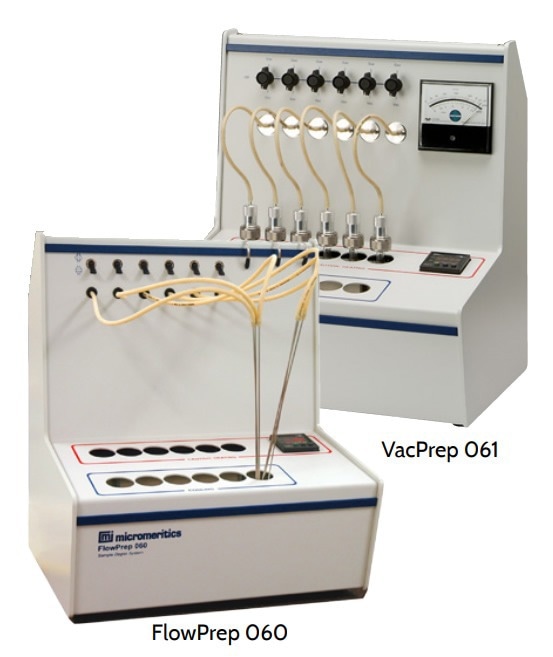
Image Credit: Micromeritics Instrument Corporation
The FlowPrep™ 060
The sample is exposed to heat and an inert gas stream via the FlowPrepTM 060. Contaminants desorb from the surface due to the heat and are swept out of the sample tube by the inert gas stream. Using this unit, users can select the ideal temperature, gas, and flow rate for the sample material and application. To stop samples from becoming fluidized, users can introduce the flowing gas gradually using needle valves.
The VacPrep™ 061
There are two approaches to cleaning contaminants with the VacPrepTM 061. It allows for gas flow and vacuum application to prepare samples through heating and evacuation. With this combination, users can select the best preparation technique for their material or intended use. Six degassing stations with a choice of vacuum or gas flow preparation are included in the VacPrep. Additionally, needle valves are offered, enabling the users to gradually introduce the flowing gas or vacuum to stop samples from becoming fluidized.
The Smart VacPrep™ 067
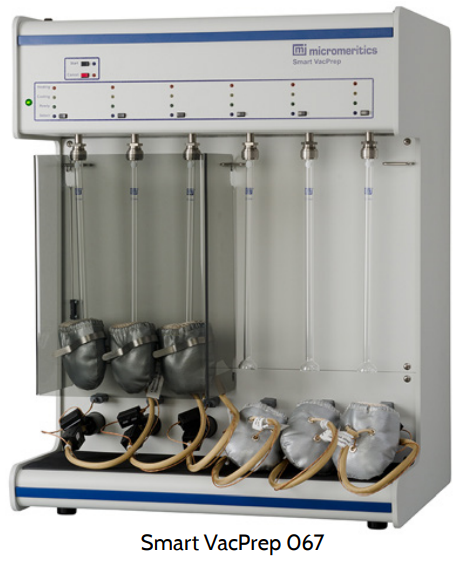
Image Credit: Micromeritics Instrument Corporation
Using vacuum to heat and evacuate samples, the Smart VacPrepTM 067 is a sophisticated six-port system. It is possible to operate each port independently. Samples can be added to or taken out of degas ports without interfering with the preparation of other samples that are being treated. When the samples have finished all of the scheduled steps, the degassing process automatically stops.
Cryogen Transfer System
The Micromeritics Cryogen Transfer System facilitates the transfer of liquid nitrogen or liquid argon from a nonpressurized storage dewar into smaller containers utilized in laboratory experiments. Special accessories are also available to cater to specific applications.
Software
Enhanced Software Capabilities, Data Reduction, and Instrument Monitoring
MicroActive Software for TriStar II Plus
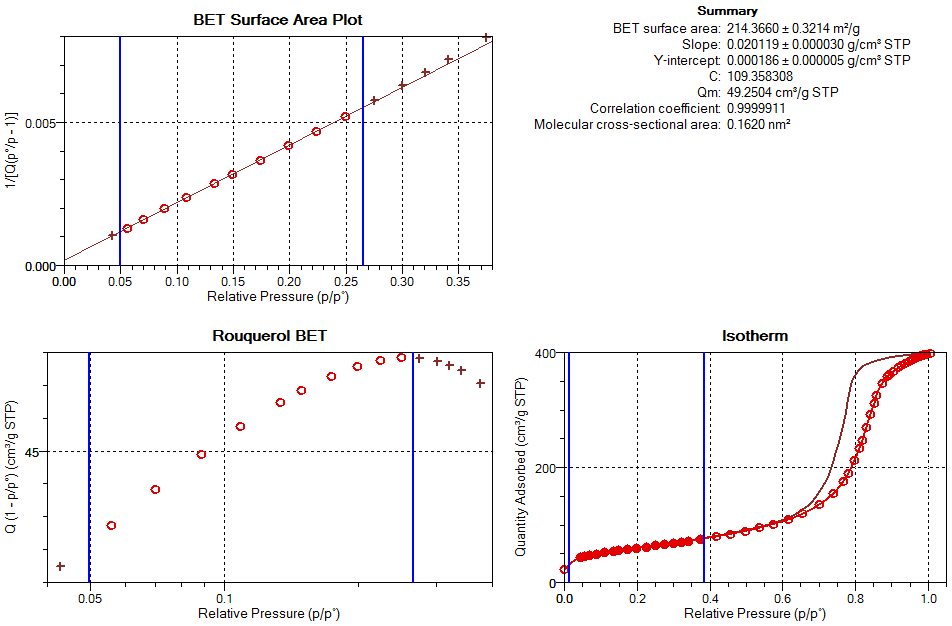
Image Credit: Micromeritics Instrument Corporation
The user can more quickly obtain surface area and porosity results by evaluating isotherm data interactively with the help of the user-friendly Micromeritics MicroActive control software for the TriStar II Plus.
To view the results, users do not need to generate reports. Calculations such as the BET surface area transform plot are easily generated and adjusted. A selection of data points can be made quickly and easily thanks to the selection bars. The summary of values obtained from the computations is updated instantaneously. The used data range can be further narrowed down within the calculation window or windows.
Gas Adsorption and Mercury Intrusion Overlay
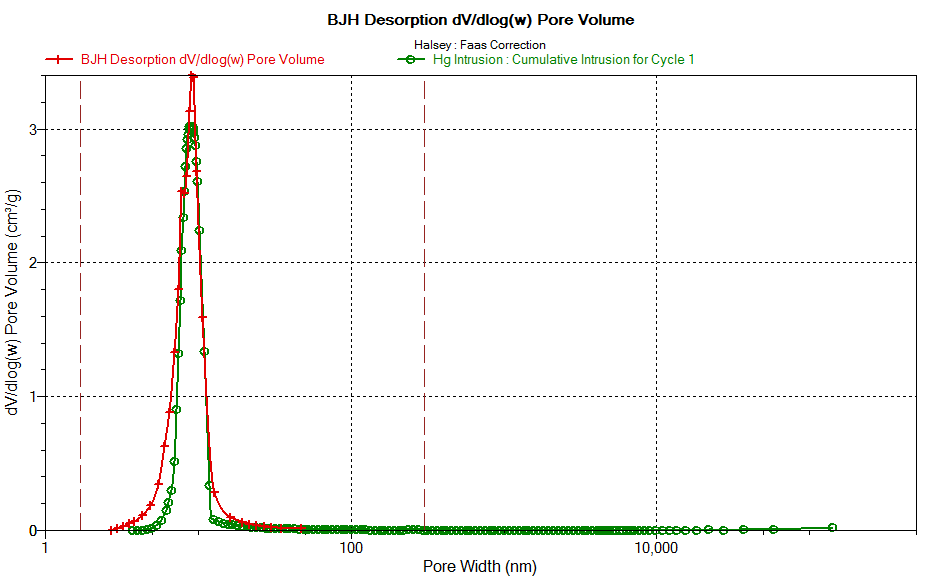
Image Credit: Micromeritics Instrument Corporation
A strong tool in the MicroActive software for the TriStar II Plus enables the user to superimpose a pore size distribution determined from gas adsorption isotherms on top of a mercury porosimetry pore size distribution. With this import feature, users can quickly view distributions of micropores, mesopores, and macropores in a single, user-friendly program.
Advanced NLDFT
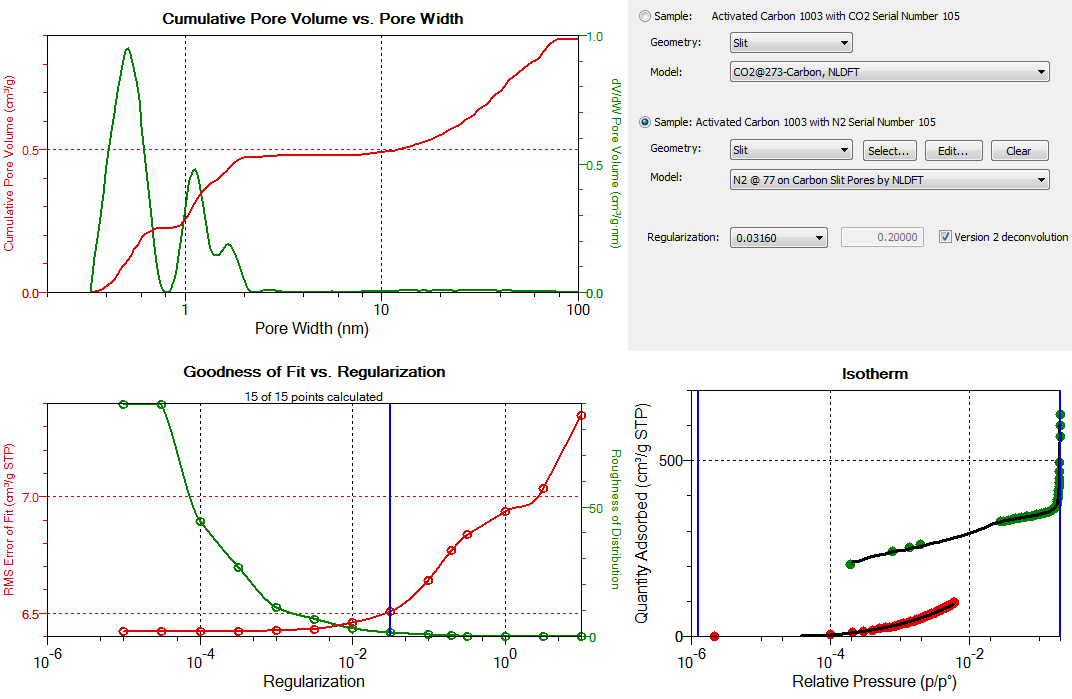
Image Credit: Micromeritics Instrument Corporation
With the use of the Advanced NLDFT model, users can obtain a complete pore size distribution on materials (like carbon slit pores) that contain pores with varying molecular sizes by merging the data obtained from nitrogen and carbon dioxide isotherms. Compared to the conventional nitrogen analysis, this method's range of pore size analysis is expanded to smaller pore sizes. This occurs because CO2 can penetrate extremely small micropores inaccessible to N2 at cryogenic temperatures owing to size limitations, connectivity issues, or exceedingly slow diffusion rates.